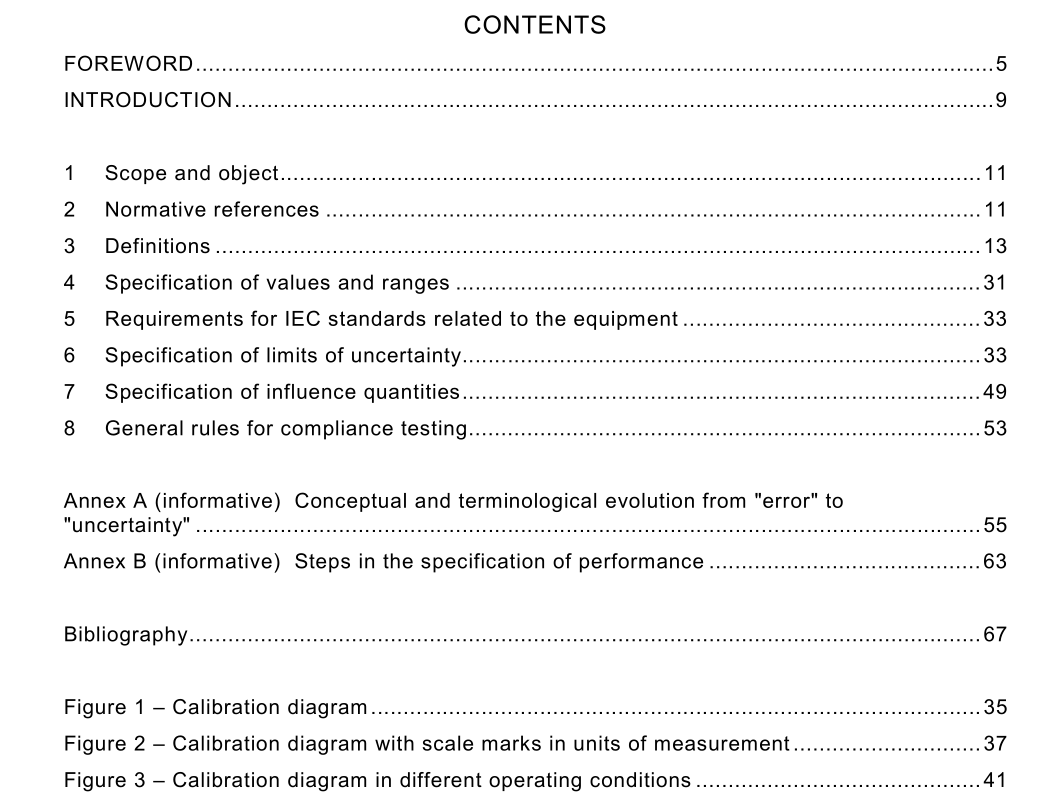IEC 60359 pdf download

IEC 60359 pdf download.Electrical and electronic measurement equipment – Expression of performance
1 Scope and object
This International Standard applies to the specification of performance, with primary reference to industrial applications, of the following kinds of electrical and electronic equipment: – indicating and recording instruments which measure electrical quantities; – material measures which supply electrical quantities; – instruments which measure non-electrical quantities using electrical means, for all parts of the measuring chain which present electrical output signals. This standard applies to the specification of performance of instruments operating in steady- state conditions (see 3.1.15), usual in industrial applications. It is based on the methods expounded in GUM for expressing and evaluating the uncertainty of measurement, and refers to GUM for the statistical procedures to be used in determining the intervals assigned to represent uncertainty (including the way to account for non- negligible uncertainties in the traceability chain). This standard does not address the propagation of uncertainty beyond the instrument (or the measuring equipment) whose performance is considered and which may undergo compliance testing. The object is to provide methods for ensuring uniformity in the specification and determination of uncertainties of equipment within its scope. All other necessary requirements have been reserved for dependent IEC product standards pertaining to particular types of equipment which fall within the scope of this standard. For example: the selection of metrological characteristics and their ranges, and of influence quantities and their specified operating ranges, is reserved for IEC product standards.
3 Definitions
For the purposes of this International Standard, the following definitions apply. A word between brackets in the title of a definition is a qualifier that may be skipped if there is no danger of confusion with a similar term. When two terms may be used interchangeably with the same definition, these are separated by “or”. Terms in italics in a note are new terms defined by the context. Most definitions are taken or adapted, together with their notes, from Part 311 of IEC 60050-300 (International Electrotechnical Vocabulary – IEV). As only terms pertaining to the “uncertainty approach” are used, IEV notes stating that the term is used in this approach were omitted. Where such definitions are simultaneously drawn from the International Vocabulary of Basic and General Terms in Metrology (VIM), this has been indicated. In some cases, notes have been added for the purposes of this standard. 3.1 Basic definitions 3.1.1 measurand quantity subjected to measurement, evaluated in the state assumed by the measured system during the measurement itself NOTE 1 The value assumed by a quantity subjected to measurement when it is not interacting with the measuring instrument may be called unperturbed value of the quantity. NOTE 2 The unperturbed value and its associated uncertainty can only be computed through a model of the measured system and of the measurement interaction with the knowledge of the appropriate metrological characteristics of the instrument, that may be called instrumental load.3.1.2 (result of a) measurement set of values attributed to a measurand, including a value, the corresponding uncertainty and the unit of measurement [IEV 311-01-01, modified] NOTE 1 The mid-value of the interval is called the value (see 3.1.3) of the measurand and its half-width the uncertainty (see 3.1.4) [IEV modified]. NOTE 2 The measurement is related to the indication (see 3.1.5) given by the instrument and to the values of correction obtained by calibration [IEV modified]. NOTE 3 The interval can be considered as representing the measurand provided that it is compatible with all other measurements of the same measurand [IEV modified]. NOTE 4 The width of the interval, and hence the uncertainty, can only be given with a stated level of confidence (see 3.1.4, NOTE 1) [IEV modified]. 3.1.3 (measure-) value mid element of the set assigned to represent the measurand NOTE The measure-value is no more representative of the measurand than any other element of the set. It is singled out merely for the convenience of expressing the set in the format V ± U, where V is the mid element and U the half-width of the set, rather than by its extremes. The qualifier “measure-” is used when deemed necessary to avoid confusion with the reading-value or the indicated value.









